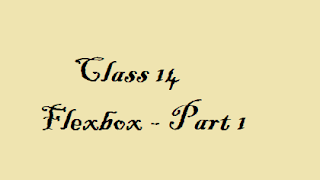Lecture Notes Of Class 14: Flexbox - Part 1
Objective:
In this class, we will introduce the Flexbox
layout, a powerful tool for creating flexible and responsive web layouts. We
will understand the concept of a flex container and
flex items, and explore the basic display: flex property
that turns an element into a flex container.
Topics:
1. Flexbox Layout:
Flexbox (Flexible Box Layout) is a CSS layout
model that allows you to create complex layouts with ease. It provides more
control over spacing, alignment, and distribution of elements within a
container. Unlike traditional layouts (like block or inline), Flexbox makes it
simple to align elements horizontally or vertically.
The main concept in Flexbox is the flex
container and flex items.
2. Flex Container and
Flex Items:
- Flex Container:
- The flex container
is the element that holds the items that you want to arrange using
Flexbox. It is defined by setting the
displayproperty toflexorinline-flex. - By default, Flexbox arranges its
items in a row (horizontally), but you can change the direction to a
column (vertically) or any other custom layout using Flexbox properties.
- Flex Items:
- The flex items
are the child elements inside the flex container. These are the elements
that will be arranged by the Flexbox model.
- Each item can be styled
individually using Flexbox properties like
flex-grow,flex-shrink, andflex-basisto control their size and spacing.
3. display: flex:
To create a flex container, you use the CSS
property display: flex
on the parent element. This enables the Flexbox model for the container and automatically
arranges its children (flex items) using the default behavior (row direction).
css.container { display: flex;}By using display:
flex, the parent container becomes a flex container, and the
child elements inside this container automatically become flex items.
Key Points:
- When you set
display: flex, the children (flex items) will automatically align in a row. - If you want to change the layout to
a column (vertical direction), you can set the
flex-directionproperty tocolumn.
Detailed Breakdown of Flexbox Properties:
- flex-direction:
- This property defines the
direction of the flex container's main axis (the direction in which the
flex items will be arranged).
- Values:
row: (default) Aligns items in a row (horizontal).column: Aligns items in a column (vertical).row-reverse: Reverses the row direction.column-reverse: Reverses the column direction.
css.container { display: flex; flex-direction: row; /* Aligns items in a row */}- justify-content:
- Aligns the items along the main
axis (horizontally when the flex-direction is
row, vertically when it'scolumn). - Values:
flex-start: Items are aligned at the start of the container.flex-end: Items are aligned at the end of the container.center: Items are aligned at the center.space-between: Items are spaced evenly, with the first item at the start and the last item at the end.space-around: Items are spaced evenly with equal space around them.
css.container { display: flex; justify-content: center; /* Align items in the center horizontally */}- align-items:
- Aligns the items along the cross
axis (perpendicular to the main axis).
- Values:
stretch: Items stretch to fill the container (default).flex-start: Aligns items to the start of the container.flex-end: Aligns items to the end of the container.center: Aligns items at the center of the container.baseline: Aligns items along their baseline.
css.container { display: flex; align-items: center; /* Align items vertically in the center */}- align-self:
- This property allows individual
flex items to override the
align-itemsvalue and align differently within the container.
css.item { align-self: flex-start; /* Align a specific item to the start */}Lab Exercise: Create a Basic Flex Layout with
Rows and Columns
Objective:
To practice the concepts learned about
Flexbox, you will create a basic layout using both rows and columns.
Steps:
1. Create
a basic HTML structure:
html<!DOCTYPE html><html lang="en"><head> <meta charset="UTF-8"> <meta name="viewport" content="width=device-width, initial-scale=1.0"> <title>Flexbox Layout</title> <link rel="stylesheet" href="styles.css"></head><body> <div class="container"> <div class="item">Item 1</div> <div class="item">Item 2</div> <div class="item">Item 3</div> <div class="item">Item 4</div> </div></body></html>
2. Style
the container using Flexbox: In the CSS file (styles.css),
set the container to be a flex container using display:
flex.
css.container { display: flex; justify-content: space-between; /* Distribute items evenly */ align-items: center; /* Align items vertically at the center */ height: 100vh; /* Full height of the viewport */ background-color: #f0f0f0;} .item { background-color: #4CAF50; color: white; padding: 20px; border-radius: 5px; text-align: center; flex: 1; /* Make each item take up equal space */ margin: 10px;}3. View the
Result:
o
This
will create a basic layout with four items arranged in a row, with equal space
between them. All items are vertically centered in the container.
o
Experiment
with different values of justify-content
(e.g., center, space-between, flex-start) to see the effect
on item distribution.
4. Modify
the Layout to Use Columns:
o
Change
the layout to a column by setting flex-direction:
column.
css.container { display: flex; flex-direction: column; /* Items will be arranged in a column */ justify-content: center; align-items: center; height: 100vh;}Conclusion:
In this class, you have learned how to use
Flexbox to create flexible and responsive layouts. By using display: flex, you turned
a container into a flex container, and by using various Flexbox properties like
justify-content,
align-items,
and flex-direction,
you can control the alignment, distribution, and direction of the flex items.







No comments:
Post a Comment